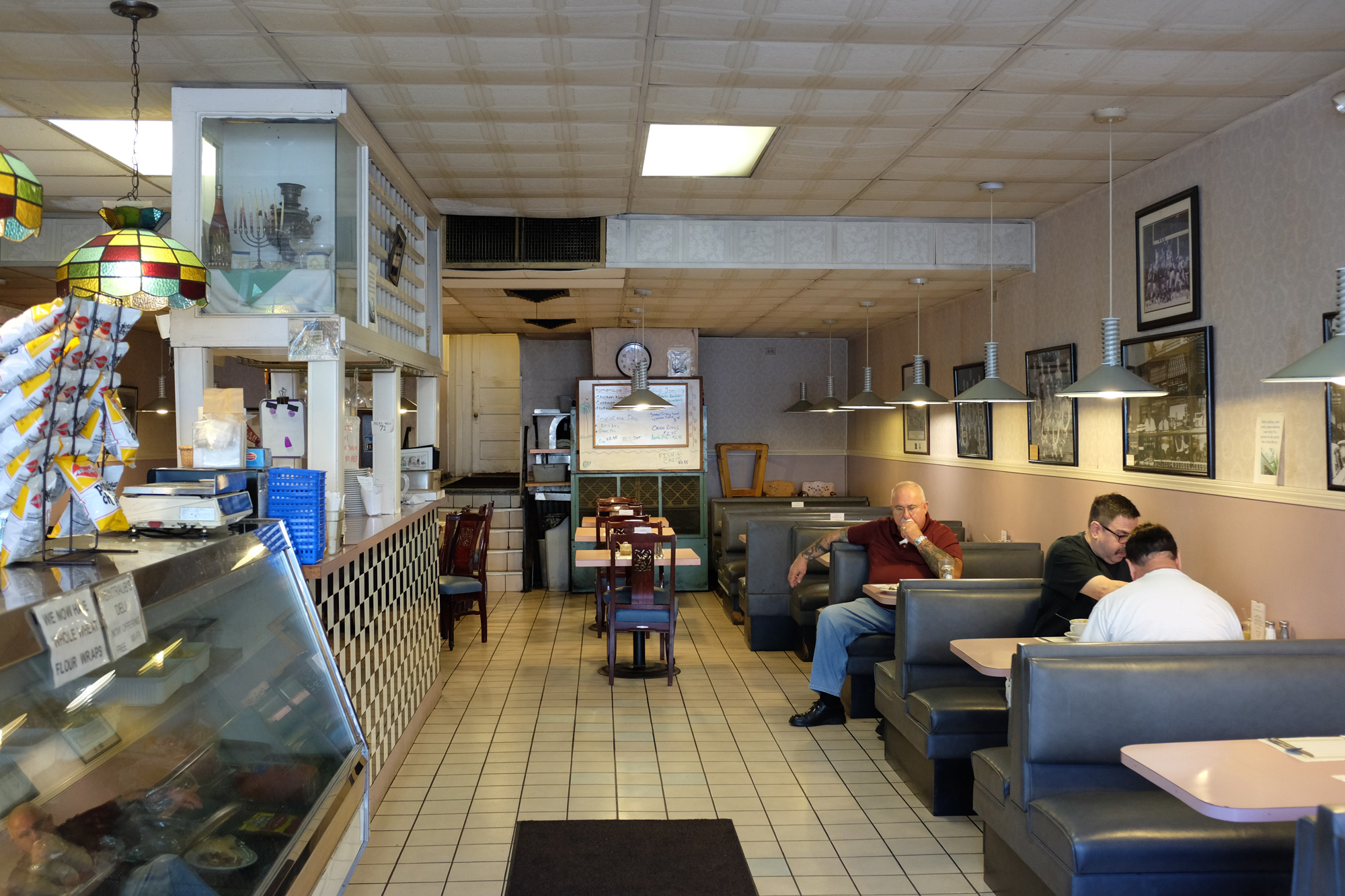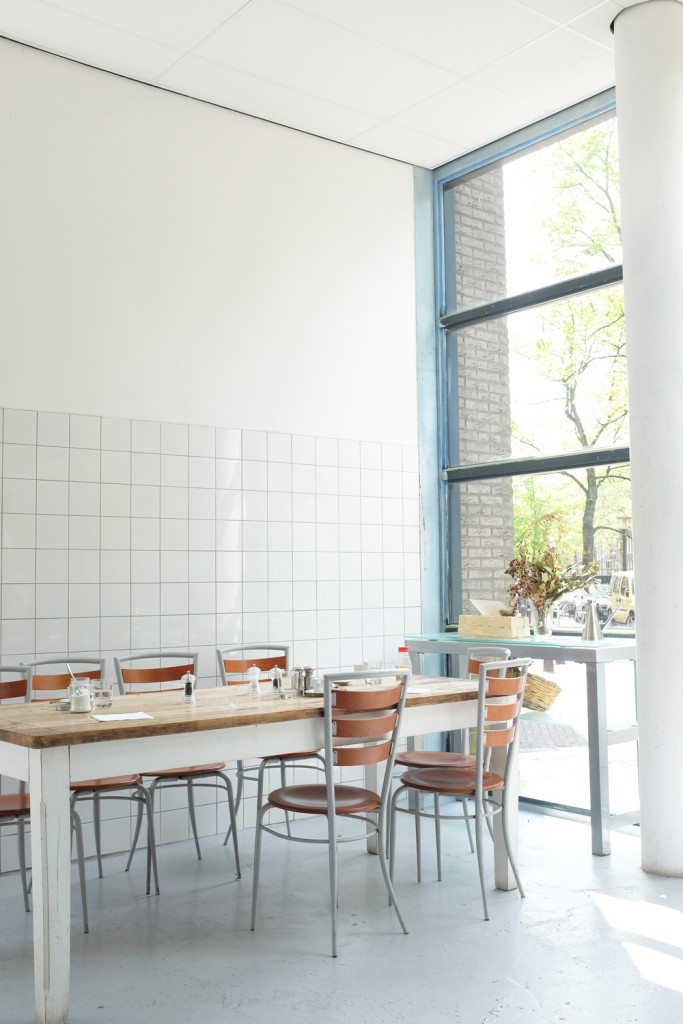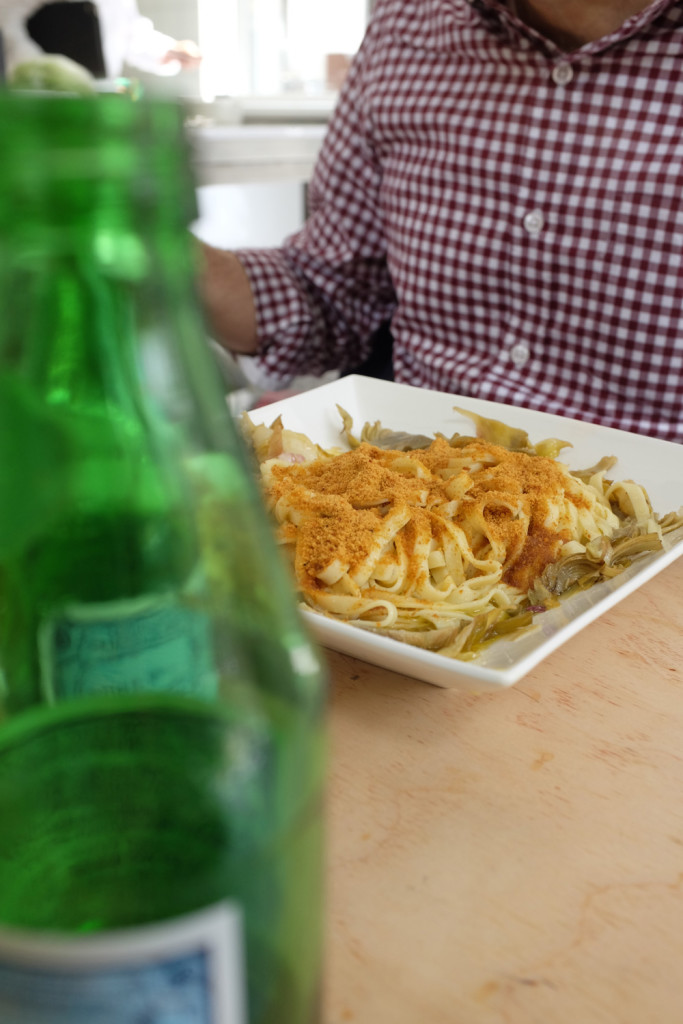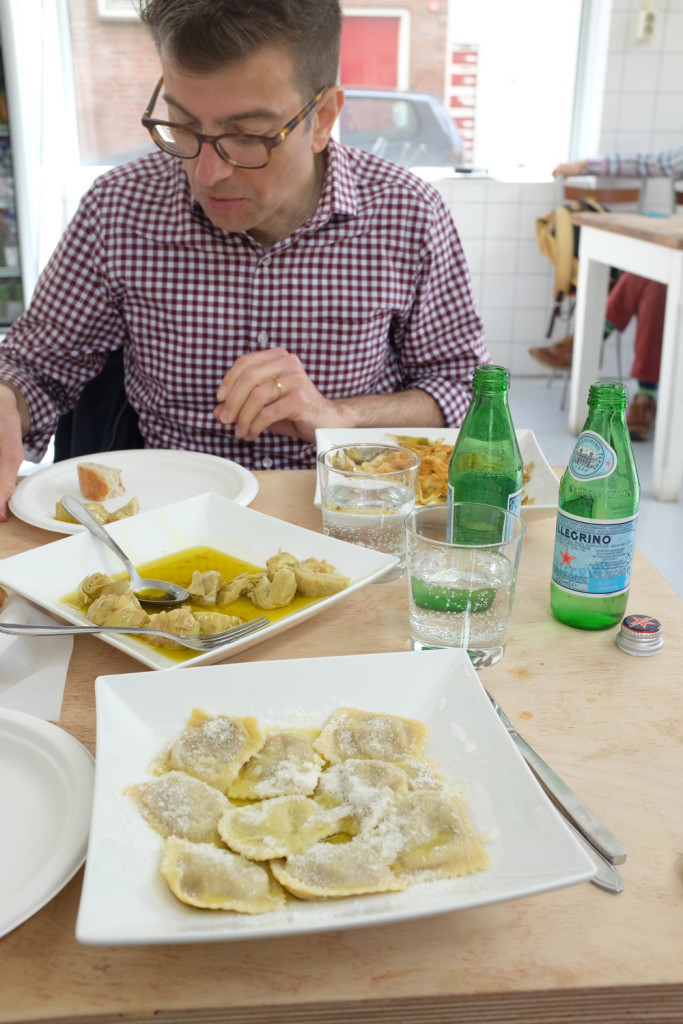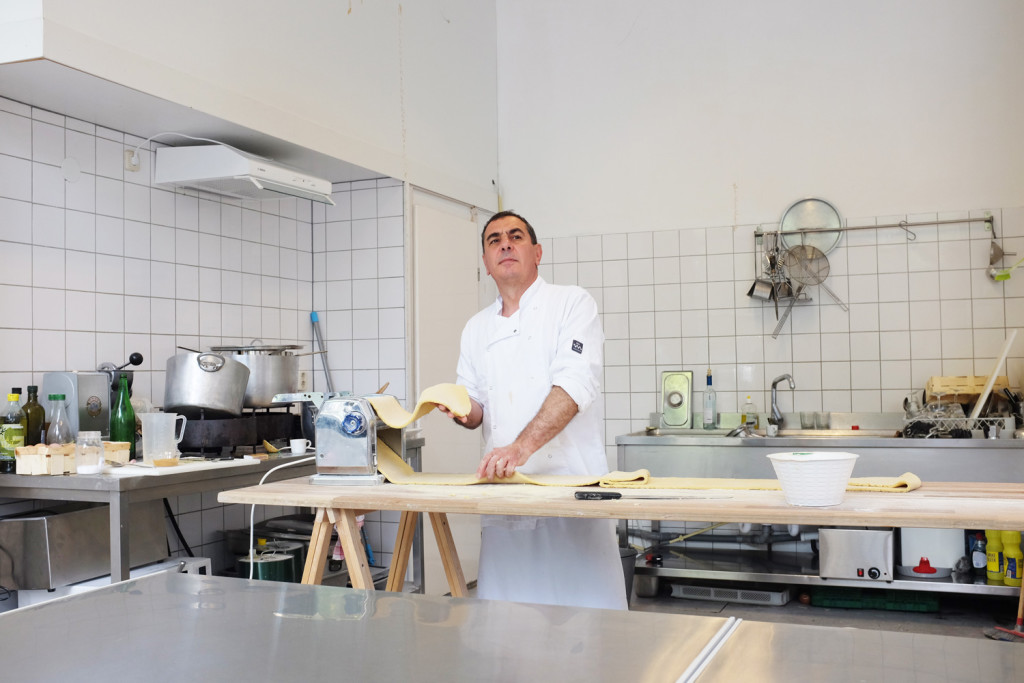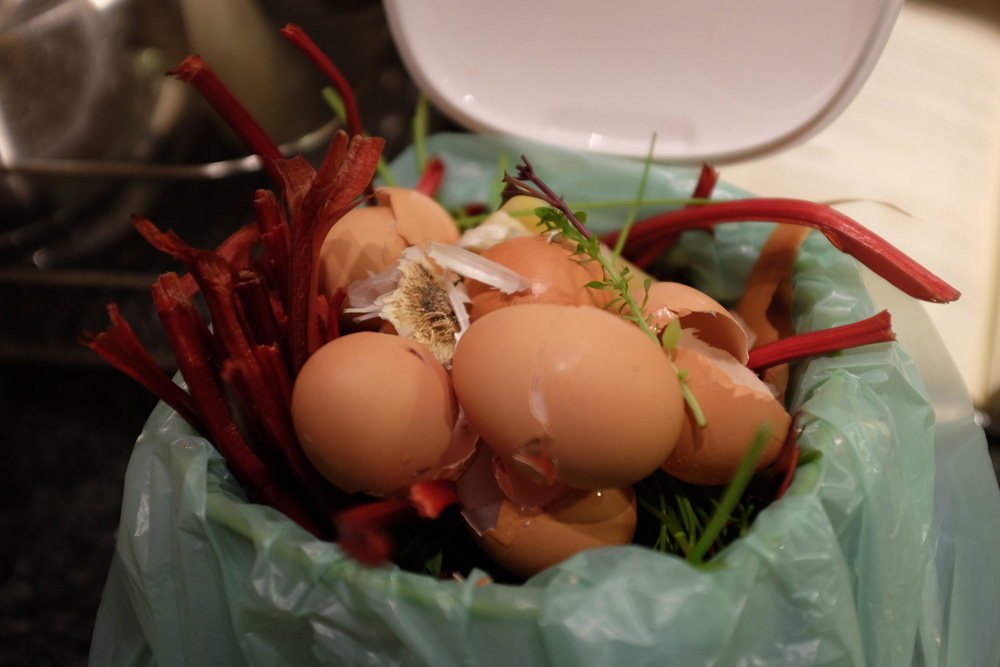We ate here regularly when I was a kid, four decades ago. It seems pretty much unchanged.
Category: Food and Drink
Winesap
Sardinia in Amsterdam
Can we eat here? I wondered, yesterday evening, as Peter and I, on vacation in Amsterdam, walked past the large windows in the photograph above. A sign taped to the glass promised fresh pasta, but although we could see a large, inviting table, I didn’t see anyone eating at it, and it seemed possible that the establishment sold pasta for takeaway only.
We could definitely eat here, a young Italian woman assured me. She explained that the chef makes ravioli and other pasta in the space—he was milling fresh noodles at a long worktable behind her as she spoke—and that they do sell it for takeway, but that they had just decided to start letting people eat on the premises as well. Peter and I were on our way to a reservation elsewhere, but she translated for us extemporaneously from a list of their ravioli, which included one of provolone picante and lemon, and one made of the local Dutch white asparagus and ricotta, and gave us a card.
Today we returned for lunch. Three Dutch men were eating at the large table, but the young woman cleared some of her things off of a smaller, square table for us. “You’re our first customers,” she said, apologizing for the improvisation. After some discussion with the chef, she placed our table near a cabinet full of artichokes in oil and drew up two chairs. When she saw me admiring the artichokes, she opened the cabinet doors and invited me to take a picture, saying she had arranged them herself. She brought out a Sardinian textile and draped it over one of the open doors, to make the tableau even prettier.
The restaurant/ravioli factory is called Salvatorica, which, the young woman told us, is the name of the chef’s mother. It’s a typical Sardinian name, the woman said, and not only do she and the chef come from the island, but so do all the pasta’s ingredients—she pointed to bags of Italian flour behind refrigerator. The chef and his sister, she said, harvest the artichokes by hand.
After offering to open a jar of the artichokes for us as an appetizer, the young woman ran through the kinds of ravioli again. A tomato sauce was available, though the chef recommended only olive oil for some of the flavors of ravioli. He had just made some tagliatelli, which he was preparing with artichokes and bottarga; Peter ordered that. I asked for ravioli with pumpkin and porcini, a Sardinian specialty, which came served with olive oil and parmesan.
The food was as good as it looks in the photos. The pumpkin in the ravioli was sweet and ever so slightly tart; the shell of the ravioli melted in one’s mouth. The tagliatelli was fruity on account of the olive oil and rich on account of the bottarga, and it had a little bite thanks to a clove of garlic. We cleared our plates. Afterward, the young woman gave us a Sardinian dessert made out of yoghurt, a blackberry marmalade (prepared by the chef’s sister), and a topping of individual blackberries (picked by the chef’s mother). Then she took down from the top of a refrigerator and shared with us a hand-carved wooden bull’s mask from Sardinia, which the chef had recently been given as a groomsman’s present at a wedding.
As charming a lunch as I’ve ever had. Highly recommended!
Salvatorica. Lijnbaansgracht 71 (at the corner of Anjelierstraat), Amsterdam. 020-758-06-19. Dining or takeout. I think they’re open from noon to 8pm, but I’m not 100% sure. They can’t take credit cards, so bring cash unless you have a Dutch bank card.
Tonight the compost bin was actually a little prettier than dinner
Rice and beans for grad students
I learn from Elif Batuman’s blog that the Muskogee, Oklahoma, Phoenix has included in its review of Keith Gessen’s novel All the Sad Young Literary Men recipes used by actual graduate students. Keith himself, evidently, was unable to provide one, suggesting that while he was a student he subsisted largely on black bread dipped in pasta sauce, which he described to himself as “pizza.” The reporter contacted several writers who at some time in the recent past were penniless, and Elif notes that “the sad young literary men didn’t really provide any recipes . . . , while the women all came through.”
One is tempted to compound the essentialism of Elif’s critique by raising the question of sexual orientation. At one period during grad school, I fantasized about writing a book about how to eat on no money a week, because I seemed to know so much about it (and so little about anything else). It’s probably just as well the book never got written, because part of it was going to include such advice as “Find out when the dollar night is at your local Burger King; in my neighborhood it’s Tuesday,” which is not really advice I would offer any more, and not just because I’m now a vegetarian. I also had an awful recipe that I liked very much at the time, which consisted of putting a gob of peanut butter and a sprinkle of soy sauce onto some just-cooked spaghetti, and mashing it up and telling myself it was “sesame noodles.” For a long time I carried around a long disquisition in my head about how, if you only had two dollars to spend at the grocery store, you should buy a jar of generic peanut butter and not a jar of generic pasta sauce. I’m afraid I no longer remember the premises or the logic that led me to this conclusion.
But there is a recipe that has survived from that era into this one; it was taught to me originally by my sister. It’s pretty cheap—not as cheap as fake sesame noodles, and not as cheap as pasta sauce on bread, but pretty reasonable, and much better for you than either of them. Herewith . . .
Rice and Beans
Make rice, the way the box tells you to, so that you’ll end up with between two and three cups of cooked rice. (If you make white rice, go through the rest of this recipe presto; if you make brown rice, go through it andante.)
While the rice is cooking, slice and fry an onion.
Chop a green pepper, and peel and chop three garlic cloves. Add them to the onion mixture, along with a shake each of salt, pepper, and cumin, and two shakes of chili powder.
Once the onion has started to brown, add an undrained can of black beans. Stir; cover; simmer. Add water if it starts to look too thick.
While the rice and beans are separately cooking, prepare as many of these toppings as you feel like or can afford: chopped cherry tomatoes, washed and chopped cilantro, shredded cheddar cheese, and pitted green olives.
Once the rice is finished, add a shake of oregano and a splash of red cider vinegar to the bean mixture and stir. Serve the rice in individual bowls with the beans ladled on top. Add the tomatoes, cilantro, cheese, and olives as desired/afforded. Makes enough for two grad students, or for one who hasn’t eaten since breakfast. No good the next day, so eat it all now.
Of course lentil soup remains the Grundrisse for all serious intellectual work in the late twentieth and early twenty-first century.


